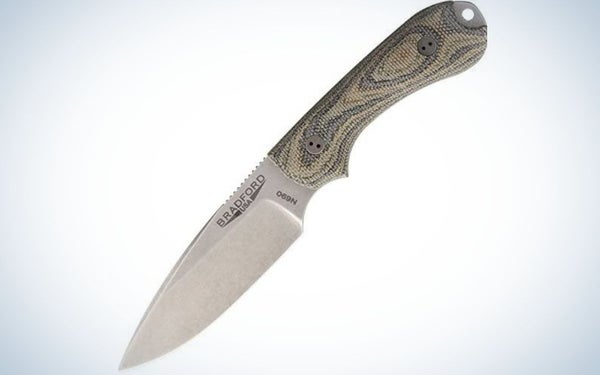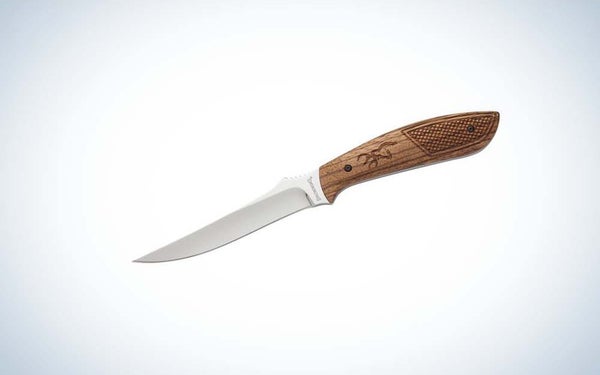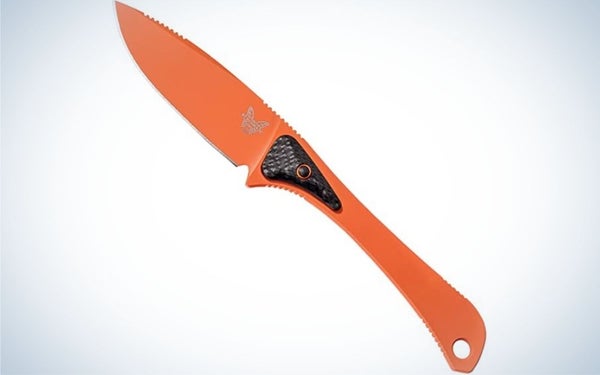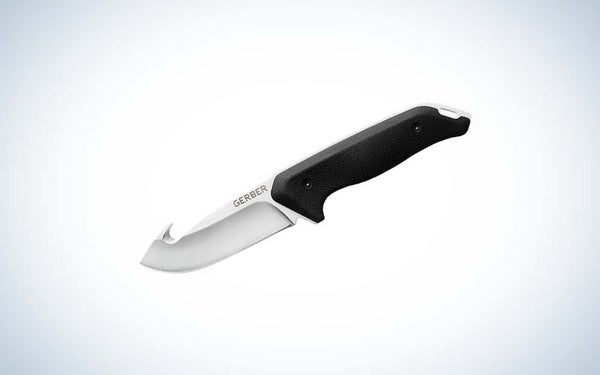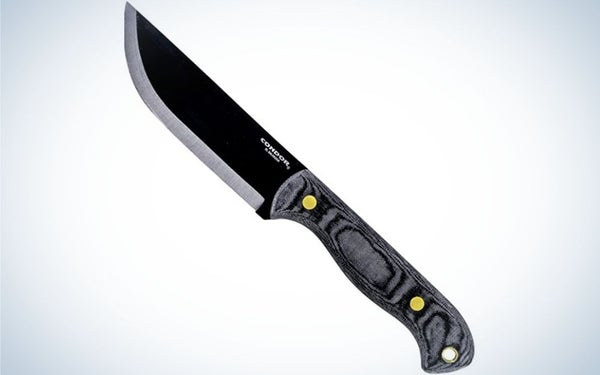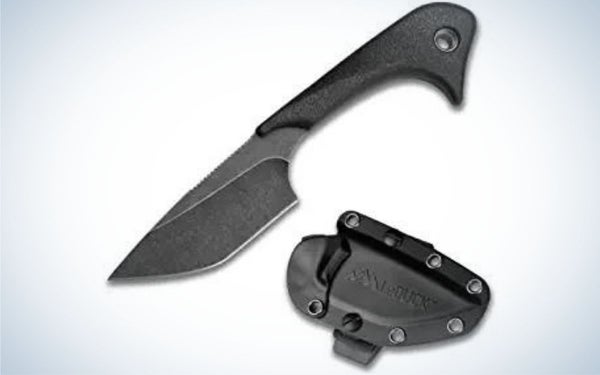| Best for the Money |
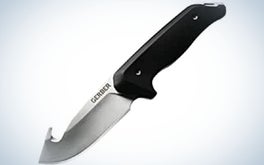
|
Gerber Moment Fixed-Blade - Gut Hook | SEE IT |
LEARN MORE
|
Summary
This knife works as well as an everyday carry knife as it does in the woods. The rubber handle grip is textured and promotes excellent fit and feel, even if the handle is bloody or wet. |
| Best Skinning Knife |
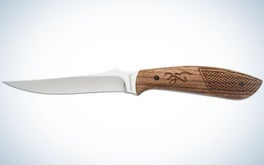
|
Browning Featherweight Classic | SEE IT |
LEARN MORE
|
Summary
The checkered Zebrawood handle feels great in hand, and the slender blade makes long cuts that work exceptionally well when the game is hanging. |
| Best Backcountry |
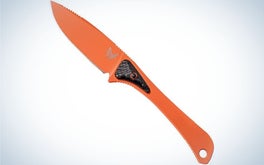
|
Benchmade 15200ORG Altitude | SEE IT |
LEARN MORE
|
Summary
This knife was crafted for the backcountry wanderer who demands a sharp, durable blade that’s featherlight. |
We may earn revenue from the products available on this page and participate in affiliate programs. Learn more ›
Most serious hunters tote a tried-and-true fixed-blade knife on every outdoor expedition. When you find one that fits your hand like a glove, carves up game cleanly, and gets meat from the field to the table, you will know why.
Before diving into fixed-blades too much further, it’s essential to understand what a fixed-blade knife is and what makes it a critical outdoor must-have. In short, a fixed-blade is a knife that doesn’t allow the blade to fold into the handle. Instead, the blade extends into the handle and can be a full- or partial-tang blade. Full tang blades are favored by most due to their durability because the steel runs through the handle’s entire length. Outdoor goers, especially those that spend lots of time cutting up meat and working around bone and joints, rave about the amount of pressure they can apply to the knife, particularly if the knife sports a comfortable grip that promotes excellent fit and feel.
Here are our picks for the best fixed-blade knives you can buy, including field dressing knives.
- Best Overall: Bradford Guardian 3
- Best Skinning: Browning Featherweight Classic
- Best Backcountry: Benchmade 15200ORG Altitude
- Best for the Money: Gerber Moment Fixed-Blade – Gut Hook
- Best Tactical: CRKT Clever Girl
- Best Bushcraft and Survival: Condor SBK
- Best Concealed Carry: Outdoor Edge LeDuck
Best Fixed-Blade Knives: Reviews & Recommendations
Best Overall: Bradford Guardian 3
Specs
- Horizontal carry
- Drop-point blade
- 6.75 in. overall length
Pros
- Compact
- Razor sharp
- Full tang
Cons
- $160-$170 is a tad steep
- Blade thickness
Branded as an everyday carry fixed-blade, this 3.42-ounce knife is a dream come true. The 3.5-inch drop-point blade is ultra-sharp, and the full-tang build boosts durability. Built for years of abuse, this small fixed-blade knife works as good on game as it does to pick out a splinter. I love the horizontal carry and leather sheath—the knife draws quickly but isn’t sloppy when in transit. You can’t beat the Guardian’s thin, easy-to-handle Micarta handle, but it is offered in G10 if you prefer that. The handle provides just enough width and girth to ensure a solid grip but isn’t bulky. It’s one of the best hunting knives because of this.

The blade’s drop point tip makes clean slices a breeze. It has a plain edge, and sharpening is easy. The 60-61 hardened Bohler M390 blade sweetens the pot, and there are 13 different color options.
Best Skinning: Browning Featherweight Classic
Specs
- Full-tang blade
- Anti-Skid Grooves on the spine
- Polished 9Cr14MoV drop-point blade
Pros
- Easy to sharpen
- Durable
- Maximum control
- Price
Cons
- Blade length is not quite 5 inches
- Like to see a polymer grip option
- Sharpen regularly
Many of my “best of” choices wear a heftier price tag, but I’m a fan of not paying for what I don’t need. Browning’s Featherweight Classic does the trick and comes with a reasonable price tag. The 4 3/8-inch mirror polished drop-point blade is as durable as the day is long and holds a solid edge as long as you touch it up from time to time. The leather sheath adds a touch of class and protects the stainless-steel blade. The blade promotes long, efficient cuts, and while the Zebrawood handle scales are a nice touch, the knife feels great in hand for a wood-handle knife. Anti-skid grooves have been added to the blade spine, and the overall build promises excellent longevity. In addition to its use as a skinner, this fixed-blade hunting knife doubles as a decent fillet knife and is one I often use when cutting my deer and elk steaks before wrapping them in freezer paper.
Best Backcountry: Benchmade 15200ORG Altitude
Specs
- Carbon Fiber and G10 Micro-Scales handle
- 3.08-inch CPM-S90V Super Premium Stainless Steel Blade
- 1.67 Ounces
Pros
- Weight
- Durability
- Maneuverability
Cons
- $245 price point
- Ultra-thin handle
At just 1.67 ounces, the lightweight Benchmade 15200ORG Altitude drop-point fixed-blade wonder can be tossed in the pack or worn on the belt in its Kydex sheath. The overall length of 7.38 inches is ideal, and when you have a knife of this weight and size, maneuverability is boosted. The knife’s edge is remarkably sharp, and it holds that edge. I’ve carved up multiple critters before having to hit the .35-inch-thick blade with a stone. I also like that the full-tang blade is part of the handle. It’s thin, which takes some getting used to, but the pair of raised Carbon fiber and G10 Mirco scales prevent the hand from slipping down, and if torque is needed, they can be gripped and used. You also get ridges that have been carved into the upper spine to help with hand and finger grip. When working on big-game animals like elk, I like to position my thumb on the carbon fiber micro scales and place my index finger on the ribbed upper spine. This grip provides maximum control. The orange finish is sexy, and I like that Benchmade added the lanyard hole, and the Kydex sheath is bulletproof.
Best for the Money: Gerber Moment Fixed-Blade – Gut Hook
Specs
- Textured rubber handle
- Gut hook
- Plain edge blade
Pros
- Great grip
- Balanced feel
- Fine edge
Cons
- Bulky
- 8.63 total inches
- Gut hook dulls quickly
If you’ve used a Gerber knife, you know why. For $30, this full-tang, 7.2-ounce fixed-blade works as well as an everyday carry knife as it does in the woods. A versatile do-all knife, the 7.3 ounce Gerber Moment Fixed-Blade provides the user great control, and the full-tang fine edge drop-point blade stays sharp. You can put some torque to it without fear of damage.
Created by Gerber for those that spend time camping, hunting, fishing, and hiking, the knife measures 8.63 inches and weighs 7.2 ounces. The button-style nylon sheath keeps the blade contained on the hip or riding in the pack. The rubber handle is beefy, and the rubberized material ensures an excellent grip and prevents slippage even when bloody or wet. The knife is easy to clean and maintain, and the addition of the gut hook feature makes the gutting and skinning of game extremely easy if the hook is sharpened regularly. The gut hook is solid, but it will need to be touched up after a few zipper jobs on big game. This is a knife that, if properly cared for, will last a lifetime, and if not, can be used and abused, and then you can drop another $30 and buy another.
Best Tactical: CRKT Clever Girl
Specs
- Upswept blade
- G10 handle
- Thermoplastic sheath with mounting options
Pros
- Great slicer and stabber
- Superior grip
- Gear compatible
Cons
- 10.13 total inches
- Concealed carry
- Thin blade
A tremendous economic self-defense knife, the CRKT Clever Girl, features an SK-5 powder-coated steel blade that measures 4.60 inches. The plain edge blade with an upswept design makes the knife a solid slasher, and when combined with the needle-point and 6.30-ounce fighting weight, the knife will puncture and penetrate. I have to give a nod of approval to the fine-point tip. This knife will slash and puncture, which is a win-win. The knife comes with a durable thermoplastic sheath with mounting options, which means the user can wear it in different ways. The G10 handle is long and features perfect curvature for the fingers to wrap around. I like a lightweight knife, but it helps to have some weight to better drive the blade forward and into the object when stabbing. The Clever Girl carries a lifetime warranty and comes in under $100.
Best Bushcraft and Survival: Condor SBK
Specs
- Micarta handle
- Kydex sheath w/leather loop
- 1075 high carbon steel blade
Pros
- Comfortable handle
- Ultra-sharp
- Durable build
Cons
- Edge retention
- Blade could be taller
A no-nonsense knife designed for survival, the Condor SBK (Straight Black Knife) works as well as deer skinner as it does as a life-saving shelter builder. The .11-inch thick blade has a width of 1.50-inches, and while the blade could be thickened and widened, it works well as is. It will hammer through small branches and debris, and I’ve gone as far as putting a hammer to the spine of the knife to punch the blade through more oversized items. The 1075 Scandi ground blade is remarkably durable, and the Micarta handle ensures a solid, no-slip grip. The Condor’s blade length and handle length are identical — 5.25 inches on the blade and 5.25 inches on the handle. For this reason, the 8.50-ounce knife is very balanced, and you can’t beat the build and versatility of the included Kydex sheath.
Best Concealed Carry: Outdoor Edge LeDuck
Specs
- 2.5-inch blade
- 6.25-inch overall build
- 360-degree rotating clip
Pros
- Light
- Great handle
- Easy to carry
Cons
- Low-end steel
- The handle could be wider
No matter where you carry the Outdoor Edge LeDuck knife, the design of the carry clip, blade, and handle work in unison to ensure a quick, clean draw. The knife doesn’t rattle or make noise in the sheath when moving, and with a weight of 3 ounces, you don’t even know it’s there. The 360-degree case is easy to conceal, and the case rotates so you can set it at any position. Overall length, at 6.25 inches, is just right, and the 2.5-inch-long blade is perfect for quick strikes and slashing. The rubberized TPR handle promotes a great grip, even if the hands are sweaty or Mother Nature is dropping moisture. The knife comes with a black 550 paracord, so it can be worn around the neck when in the sheath. It’s an economic knife with low-grade steel, but it serves its purpose for tactical carry.
What To Consider When Choosing a Fixed-Blade Knife
Blade Length and Build
Fixed-blade knives come in multiple blade lengths, and length is something to consider before purchasing. Every ounce counts when I’m chasing elk in the backcountry, and the longer the blade, the more the knife is going to weigh. When working with heavy-boned animals positioned at awkward angles on a mountainside, I’ve discovered that I don’t want a blade over 4.5 inches, and a knife’s total length needs to be under 8.5 inches. Maneuverability is as essential as weight, and you don’t want to be fighting a knife with a long blade and handle.
When I was working as a hunting guide and had multiple deer on the skinning rack back at the lodge, I opted for a longer blade and handle. A longer blade and handle allowed me to work faster and make longer skinning cuts, and I also preferred a beefier blade. With a mechanical sharpener by my side, I was more reckless about what I cut through and how much pressure I put on the edge by pushing into the handle. A longer, beefier fixed-blade can handle this type of abuse.
The crowd that doesn’t want a fixed-blade knife for hunting or outdoor use, but instead craves an everyday carry knife that conceals easily and is excellent for self-defense, will need to consider other features. The most important, arguably, is the knife’s grip. A tactical knife should have a grip and overall build that promotes gross- and not fine-motor use. Self-defense situations are intense, and you don’t want to fumble with your weapon. Most personal-defense knives are lightweight, sport a blade length under four inches, and have a non-slip polymer grip. However, more extended models are available, and I don’t mind a more sword-like length and heavier weight for making long slashes and quick jabs.
Blade Type
The type of blade you select should be based on what plans you have for your knife. For instance, hunters often favor a drop-point edge because it’s easy to control and has a large belly for slicing. Wharncliffe and Sheepsfoot blades are also practical for hunting and showcase a design that makes it hard to puncture guts and intestines with the point. Both, however, also work well as around-the-house or camp blades. Self-defense gurus often favor a Tanto Blade. Constructed from the same principles crucial to top samurai swords, the tip is tough, sharp, and designed to pierce objects quickly.
Other Factors
I could pen more, much more, about things to consider before making a fixed-blade purchase. There are multitudes of grip options, and many will want to consider how they will carry the knife. Do your research, and don’t be afraid to visit a brick and mortar knife shop or try a few out at a large box store.
FAQs
Q: What is the most versatile fixed-blade knife?
A question everyone wants answered, I will tell you versatility is in the eye of the beholder. What makes a knife versatile for one person won’t make it versatile for another. However, things that boost versatility are weight — stay away from heavy blades — and length. A versatile knife will be shorter in length, and most looking for an everyday carry knife that will serve many purposes rarely want a blade length over 3.5 inches or a total length over 7 inches. A drop-point blade style is versatile, and I prefer a polymer-style handle over wood or bone.
Q: How old does a knife have to be to be vintage?
Not that old, as vintage looks are popular on modern-day knife builds. However, an actual vintage knife will have a wood, bone, or antler handle, and most knife experts note that vintage knives, like the legendary Marbles Ideal, have to be about 100 years old.
Q: What does fixed-blade length mean?
Simple. This is the blade’s length and is measured from the point to the handle. There are full- and partial-tang fixed blades, but the length does not include the portion of the blade that runs up into the handle. If a fixed-blade knife has a 4.25-inch blade, the measurement protrudes out from the handle.
Q: What is the most effective knife in combat?
Don’t get hung up on a brand. The best combat knives will have an easy-to-grip handle, draw quickly from a sheath, and give the user maximum control. Most blade lengths are less than five inches and are designed with a rugged, needle-point tip that will puncture quickly and precisely. Some blades will have serration, which will cause more internal damage, especially if the blade is twisted once inserted. Weight is also something to be considered, and some like a bit of heft, as the weight helps drive the blade forward.
Q: Is a fixed-blade knife a pocket knife?
No. A fixed-blade knife will come with a sheath, and that sheath, depending on the construction, allows the knife to be attached to a belt, backpack strap, etc. Try and stick a fixed-blade knife in your pocket, and you’ll be making a trip to the emergency room. If you’re looking for a knife to place in your pocket, that knife must be fitted with a blade that folds back into the knife’s body. Check out our roundup of the best pocket knives to find a good option for your belt.
Q: How much does a fixed-blade knife cost?
Prices vary by make and quality. Most fixed-blade knives will be under $150, but if the knife is custom or made by a manufacturer renowned for producing high-end blades, the price tag could be $300-$500.
Best Fixed-Blade Knives: Final Thoughts
- Best Overall: Bradford Guardian 3
- Best Skinning: Browning Featherweight Classic
- Best Backcountry: Benchmade 15200ORG Altitude
- Best for the Money: Gerber Moment Fixed-Blade – Gut Hook
- Best Tactical: CRKT Clever Girl
- Best Bushcraft and Survival: Condor SBK
- Best Concealed Carry: Outdoor Edge LeDuck
I love knives, and I have lots of them. A good fixed-blade is my go-to for almost any situation, though. They serve me well in the backcountry, when camping with family and friends, and in survival situations. There are one-size-fits-all fixed blades, but don’t be afraid to build a collection of knives intended for different purposes. Even if you never use them, the best fixed-blade knives make great heirlooms and hold their value.
Why Trust Us
For more than 125 years, Field & Stream has been providing readers with honest and authentic coverage of outdoor gear. Our writers and editors eat, sleep, and breathe the outdoors, and that passion comes through in our product reviews. You can count on F&S to keep you up to date on the best new gear. And when we write about a product—whether it’s a bass lure or a backpack—we cover the good and the bad, so you know exactly what to expect before you decide to make a purchase.

